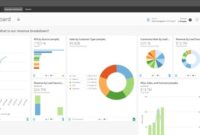Excel Business Intelligence: A gateway to data-driven decision-making, empowering businesses to harness the power of data for exceptional outcomes. Dive into the world of Excel’s robust capabilities, where data analysis, visualization, and automation converge to transform raw data into actionable insights.
Excel business intelligence is a powerful tool that can help you make better decisions for your business. If you’re interested in learning more about how to use Excel for business intelligence, check out our guide on how to become a business intelligence analyst.
This guide will teach you everything you need to know to get started with Excel business intelligence, from importing data to creating dashboards and reports.
Excel’s prowess in data analysis, visualization, and automation makes it an indispensable tool for businesses seeking to gain a competitive edge. With its intuitive interface and extensive feature set, Excel empowers users to explore, analyze, and present data in ways that reveal hidden patterns, trends, and opportunities.
Excel’s Data Analysis Capabilities
Excel is a powerful tool for data analysis, with a robust suite of tools that make it easy to explore, manipulate, and analyze data. Its statistical functions allow you to perform complex calculations, while pivot tables and charting capabilities help you summarize and visualize data in meaningful ways.
Excel’s business intelligence capabilities are powerful, enabling you to analyze data and make informed decisions. But how does it compare to dedicated business intelligence tools? Understanding the difference between business intelligence and analytics is crucial for choosing the right solution for your needs.
Check out our article business intelligence vs analytics to learn more. With Excel’s robust features, you can harness the power of business intelligence to drive your business forward.
Statistical Functions
- Excel offers a wide range of statistical functions, including mean, median, mode, standard deviation, and variance.
- These functions can be used to analyze data, identify trends, and make predictions.
Pivot Tables
- Pivot tables are a powerful tool for summarizing and analyzing large datasets.
- They allow you to group and aggregate data by multiple criteria, making it easy to identify patterns and trends.
Charting Capabilities
- Excel’s charting capabilities make it easy to visualize data in a variety of ways, including bar charts, line charts, and pie charts.
- Charts can help you quickly identify trends, patterns, and outliers.
Data Visualization for Business Insights
Excel’s visualization features make it easy to understand and communicate complex data. Charts, graphs, and dashboards help you identify trends, patterns, and outliers, making it easier to make informed decisions.
Charts and Graphs

- Excel offers a variety of charts and graphs, including bar charts, line charts, and pie charts.
- These visualizations can help you quickly identify trends, patterns, and outliers.
Dashboards, Excel business intelligence
- Dashboards are a powerful way to track key performance indicators (KPIs) and monitor progress over time.
- Excel’s dashboard features make it easy to create custom dashboards that meet your specific needs.
Integration with External Data Sources
Excel can connect to a variety of external data sources, including databases, spreadsheets, and web services. This makes it easy to import and analyze data from multiple sources, giving you a complete view of your business.
Database Connectivity
- Excel can connect to a variety of databases, including SQL Server, Oracle, and MySQL.
- This allows you to import data from your database into Excel for analysis.
Spreadsheet Import
- Excel can import data from other spreadsheets, including CSV and TSV files.
- This makes it easy to combine data from multiple sources into a single spreadsheet.
Web Service Integration
- Excel can connect to web services, allowing you to import data from the web.
- This makes it easy to access data from a variety of sources, including social media and financial websites.
Automation and Efficiency

Excel’s automation features can streamline business processes and save you time. Macros, formulas, and conditional formatting can be used to automate repetitive tasks, freeing you up to focus on more strategic initiatives.
Macros
- Macros are a powerful way to automate repetitive tasks in Excel.
- They can be used to record a series of steps and then replay them with a single click.
Formulas
- Excel’s formulas can be used to perform calculations and automate tasks.
- They can be used to create complex calculations, such as financial models and statistical analysis.
Conditional Formatting
- Conditional formatting can be used to highlight data that meets certain criteria.
- This makes it easy to identify trends, patterns, and outliers.
Real-World Applications in Business
Excel is a powerful tool that can be used to improve decision-making and enhance performance in a variety of business applications.
Financial Analysis
- Excel can be used to create financial models, analyze financial data, and make investment decisions.
- Its robust data analysis tools and visualization features make it easy to identify trends and patterns in financial data.
Operations Management
- Excel can be used to track inventory, manage projects, and improve operational efficiency.
- Its automation features can streamline business processes and save time.
Marketing Campaigns

- Excel can be used to track marketing campaign performance, analyze customer data, and identify opportunities for improvement.
- Its visualization features make it easy to identify trends and patterns in marketing data.
Best Practices and Considerations
To get the most out of Excel for business intelligence, it is important to follow best practices and consider the limitations of the tool.
Excel is a powerful tool for business intelligence, but it can be difficult to know where to start. That’s where our guide to business analytics vs business intelligence comes in. We’ll show you how to use Excel to gather data, analyze it, and create reports that can help you make better decisions for your business.
With Excel, you can easily track your progress, identify trends, and forecast future performance.
Best Practices
- Use clear and concise data.
- Validate your data before using it for analysis.
- Use appropriate charts and graphs to visualize your data.
- Automate repetitive tasks to save time.
Limitations
- Excel can be limited when working with large datasets.
- It is not a substitute for a dedicated business intelligence tool.
- It is important to be aware of the limitations of Excel and use it accordingly.
Ultimate Conclusion
In conclusion, Excel Business Intelligence is not just a tool; it’s a strategic asset for businesses seeking to unlock the full potential of their data. By embracing Excel’s capabilities, businesses can gain a deeper understanding of their operations, make informed decisions, and drive growth. Whether you’re a seasoned data analyst or a business leader looking to leverage data for success, Excel Business Intelligence is your key to unlocking the power of data-driven decision-making.
Quick FAQs: Excel Business Intelligence
What are the key benefits of using Excel for business intelligence?
Excel Business Intelligence offers a wide range of benefits, including enhanced data analysis capabilities, improved data visualization for better decision-making, seamless integration with external data sources, automation of repetitive tasks for increased efficiency, and real-world applications in various business domains.
How can Excel help businesses make better decisions?
Excel Business Intelligence empowers businesses to make better decisions by providing them with data-driven insights. Through its robust data analysis tools, visualization features, and automation capabilities, Excel helps businesses identify trends, patterns, and outliers in their data, enabling them to make informed decisions based on concrete evidence.
Is Excel Business Intelligence suitable for businesses of all sizes?
Yes, Excel Business Intelligence is suitable for businesses of all sizes. Its intuitive interface and scalable features make it accessible to both small businesses and large enterprises. Whether you’re a startup looking to gain insights from your data or a multinational corporation seeking to optimize your operations, Excel Business Intelligence can cater to your needs.




